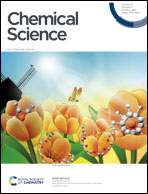Controlled mutation in the replication of synthetic oligomers†
Abstract
Replication of sequence information with mutation is the molecular basis for the evolution of functional biopolymers. Covalent template-directed synthesis has been used to replicate sequence information in synthetic oligomers, and the covalent base-pairs used in these systems provide an opportunity to manipulate the outcome of the information transfer process through the use of traceless linkers. Two new types of covalent base-pair have been used to introduce mutation in the replication of an oligotriazole, where information is encoded as the sequence of benzoic acid and phenol monomer units. When a benzoic acid–benzoic acid base-pairing system was used, a direct copy of a benzoic acid homo-oligomer template was obtained. When a phenol–benzoic acid base-pairing system was used, a reciprocal copy, the phenol homo-oligomer, was obtained. The two base-pairing systems are isosteric, so they can be used interchangeably, allowing direct and reciprocal copying to take place simultaneously on the same template strand. As a result, it was possible to introduce mutations in the replication process by spiking the monomer used for direct copying with the monomer used for reciprocal copying. The mutation rate is determined precisely by the relative proportions of the two monomers. The ability to introduce mutation at a controlled rate is a key step in the development of synthetic systems capable of evolution, which requires replication with variation.



 Please wait while we load your content...
Please wait while we load your content...